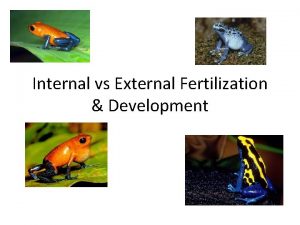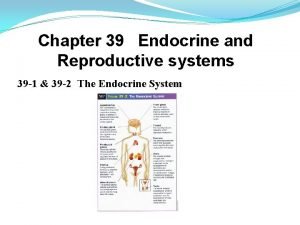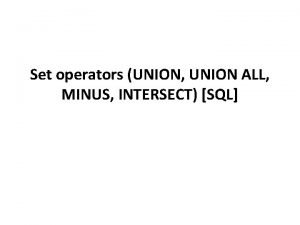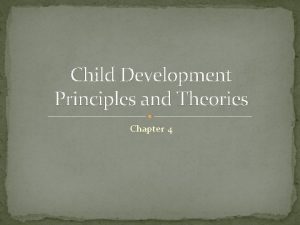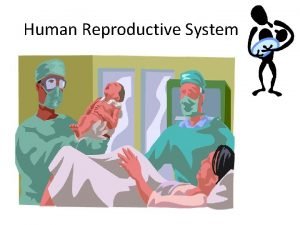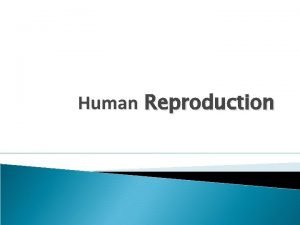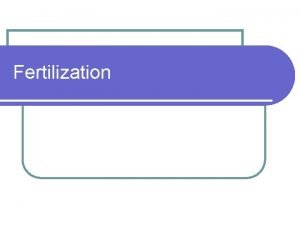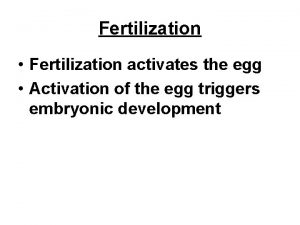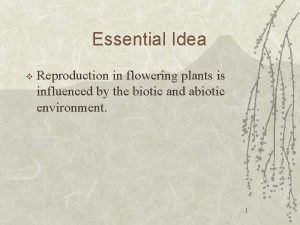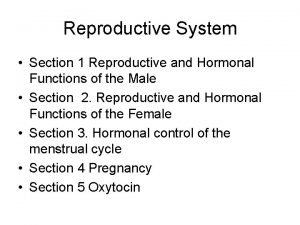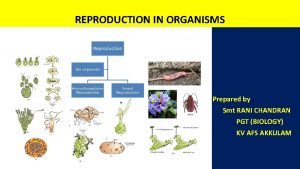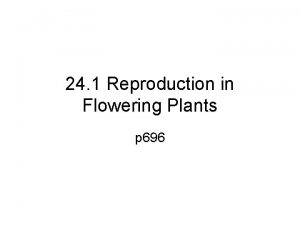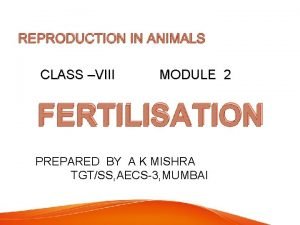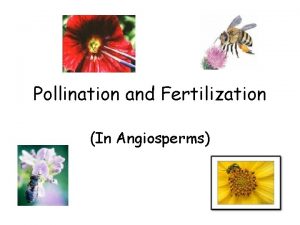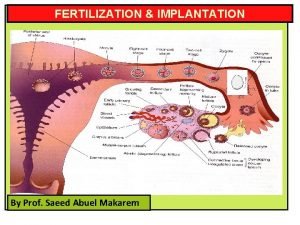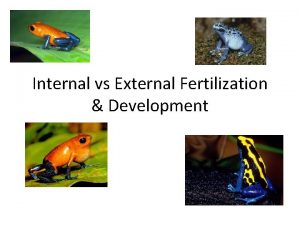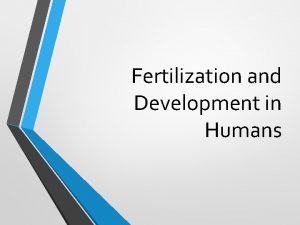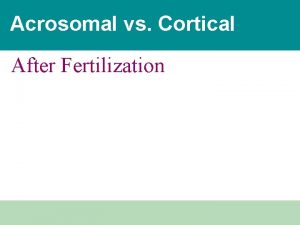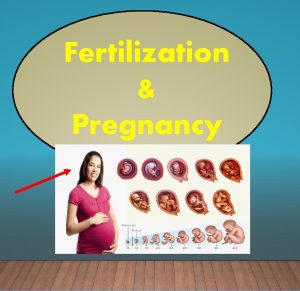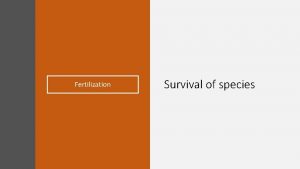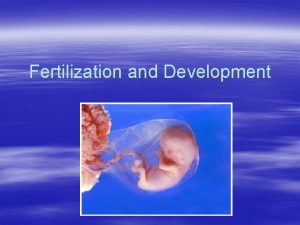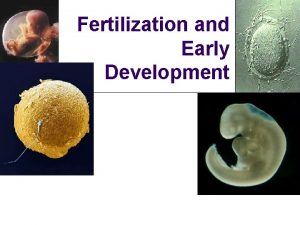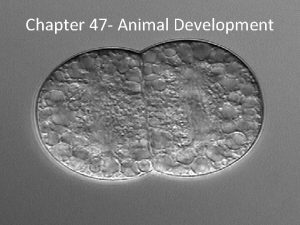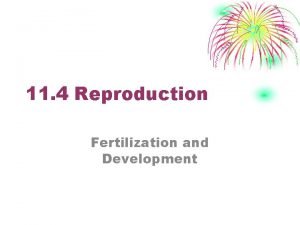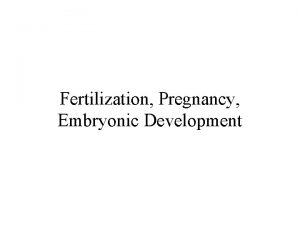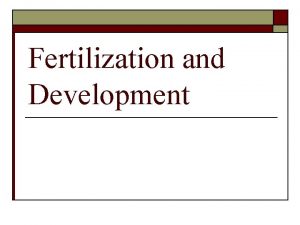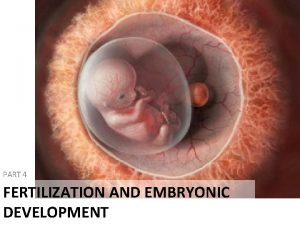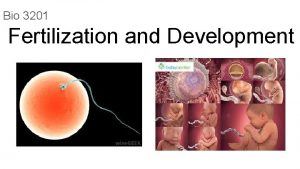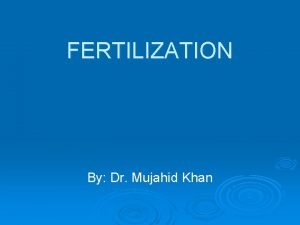Principles of Development Chapter 8 Fertilization The union




















- Slides: 20

Principles of Development Chapter 8

Fertilization § The union of male and female gametes to form a zygote. § Fertilization accomplishes two things: 1. it provides for recombination of paternal and maternal genes (restoring the original diploid number of chromosomes). 2. activates the egg to begin development § Some species can be artificially induced to initiate fertilization (artificial parthenogenesis) and some don’t need sperm at all (parthenogenesis).


Cleavage and Early Development § During cleavage the embryo divides repeatedly to convert the large cytoplasmic mass into a large cluster of small, maneuverable cells called blastomeres. § No growth occurs during this period, only subdivision of mass, which continues until normal somatic cell size is attained. § At the end of cleavage, the zygote has been divided into many hundreds or thousands of cells and the blastula stage is formed

§ The yolk-rich end is the vegetal pole and the other end is the animal pole. § During each division, a distinct cleavage furrow is visible in the cell. § Isolecithal – very little yolk, evenly distributed § Mesolecithal – moderate yolk, concentrated at vegetal pole § Telolecithal – lots of yolk, concentrated at vegetal pole § Explain the difference between holoblastic and meroblastic eggs

Development After Cleavage § Blastulation: - cleavage leads to a cluster of cells called a blastula - In most animals, the cells are arranged around a central fluid-filled cavity called a blastocoel.

§ Gastrulation: - during gastrulation, the spherical blastula is converted into a more complex configuration forming a second germ layer. - The sphere is pushed inward forming a pouch called an archenteron or a gastrocoel. The opening to the pouch/gut is called a blastopore. - The gastrula stage has two layers of cells surrounding the blastocoel: ectoderm – outer skin endoderm – inner skin

A – ectoderm B – blastocoel C – archenteron/gastrocoel D – endoderm E – blastopore

Formation of a Complete Gut § If the gut only opens at the blastopore it is called an incomplete gut (sea anemones and flatworms) - food must be completely digested or undigested parts egested back through the mouth. § Most animals have a complete gut with a second opening, the anus § When a complete gut forms, the archenteron moves inward until it meets the ectodermal wall of the gastrula. The endodermal tube now has two openings.

Formation of Mesoderm § Animals with two germ layers are called diploblastic (ex. Sea anemones and comb jellies). Most animals have a third germ layer and are triploblastic. § The third layer is called the mesoderm and lies between the endoderm and ectoderm. § At the end of gastrulation, ectoderm covers the embryo, and mesoderm and endoderm have been brought inside. As a result, cells have new positions and new neighbors, so interactions among cells and germ layers then generate more of the body plan.

Formation of the Coelom § Cells forming mesoderm are derived from the endoderm, but there are two ways that a middle tissue layer of mesoderm can form, schizocoely and enterocoely. schizocoelous – mesodermal cells fill the blastocoel, forming a solid band of tissue around the gut. *then through programmed cell death, space (coelom) opens inside the mesodermal band. *the embryo now has two body, the gut and the coelom.

Formation of the Coelom enterocoelous (deuterostomes) – mesoderm forms when cells from the central portion of the gut lining begin to grow outward as pouches, expanding into the blastocoel. *as the pouches move outward, they enclose a space which becomes a coelomic cavity or coelom * the coelom completely fills the blatocoel. *the embryo has two body cavities, a gut and a coelom

Formation of the Coelom § A coelom is a body cavity completely surrounded by mesoderm. § The mesoderm with its internal coelom lies inside the space previously occupied by the blastocoel. § When coelom formation is complete, the body has three germ layers and two cavities.


§ There are two major groups of triploblastic animals: - protostomes - deuterostomes § The groups are identified by a suite of four developmental characters: 1. radial or spiral positioning of cells as they cleave 2. regulative or mosaic cleavage of cytoplasm 3. fate of the blastopore to become mouth or anus 4. schizozoelous or enterocoelous formation of coelom

Deuterstome Development § Cleavage Patterns: radial cleavage – embryonic cells are arranged in radial symmetry around animalvegetal axis regulative development – fate of a cell depends on its interactions with neighboring cells; cell fates are not fixed early in development. - each cell is able to produce entire embryo if separated from other cells

§ Fate of Blastopore: blastopore become anus and second opening becomes the mouth § Coelom Formation: coelom formation – coelom forms by enterocoely. Both the mesoderm and coelom are formed at the same time. § Slight variations may occur depending on the animal being studied. § Examples: mammals, reptiles, birds, and fish

Protostome Development § Cleavage Patterns spiral cleavage – cleavage planes are diagonal to the polar axis mosaic development – cell fate is determined by the distribution of certain proteins and messenger RNA’s, called morphogenetic determinants. § Fate of Blastopore becomes the mouth and the second opening becomes the anus

§ Coelom Formation - coelom forms by splitting (schizocoely) - mesoderm forms when endodermal cells arise ventrally at the lip of the blastopore § Examples: segmented worms, molluscs, arthropods, roundworms

 Internal vs external fertilisation
Internal vs external fertilisation Section 39-4 fertilization and development
Section 39-4 fertilization and development Union union all intersect
Union union all intersect Child development principles and theories answer key
Child development principles and theories answer key Is salamander external fertilization
Is salamander external fertilization Parthenogenesis
Parthenogenesis Note on hypothalamus
Note on hypothalamus Fertilization occurs
Fertilization occurs First week of development
First week of development Sperm and egg fertilization process
Sperm and egg fertilization process Angiosperms double fertilization
Angiosperms double fertilization Salamander fertilization
Salamander fertilization Lesson 15.4 ovulation fertilization and implantation
Lesson 15.4 ovulation fertilization and implantation Physiological function of estrogen
Physiological function of estrogen Post fertilization events
Post fertilization events Events of fertilization in plants
Events of fertilization in plants What part of the flower is female
What part of the flower is female Double fertilization in angiosperms
Double fertilization in angiosperms Fertisation
Fertisation Double fertilization in angiosperms
Double fertilization in angiosperms Define fertilization
Define fertilization
